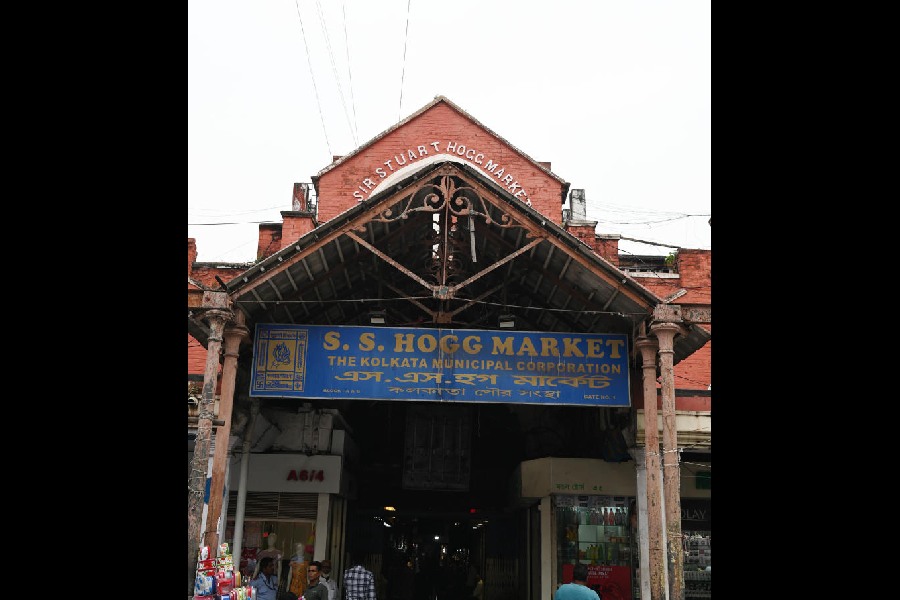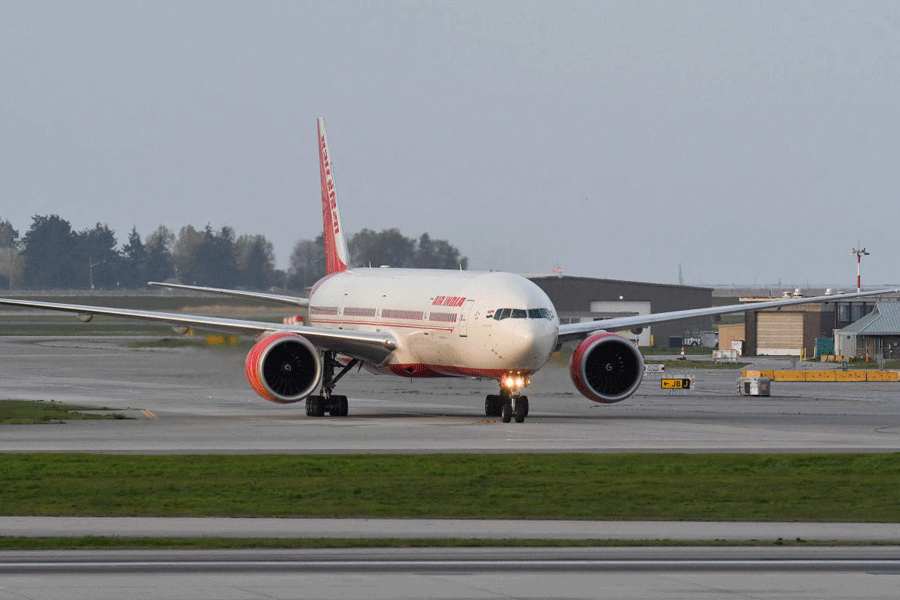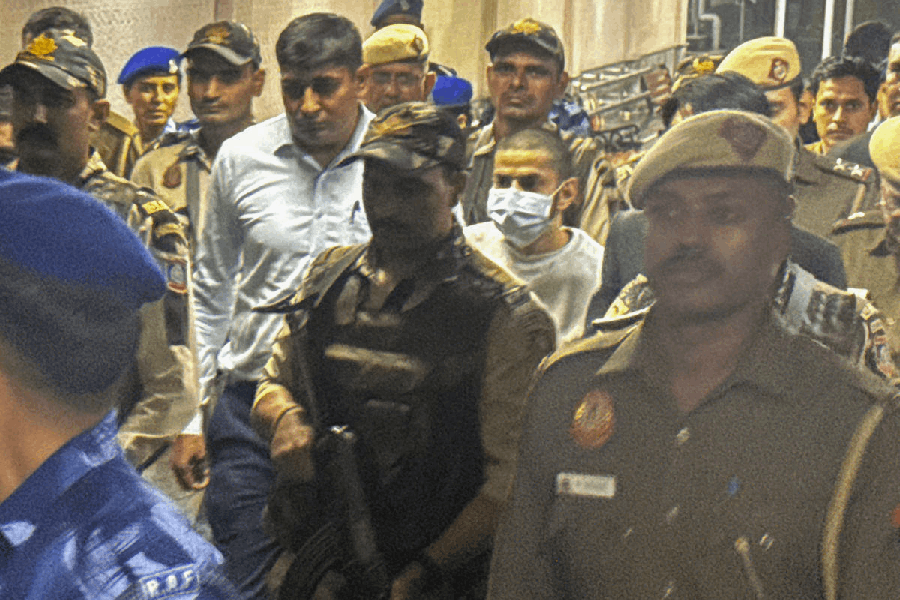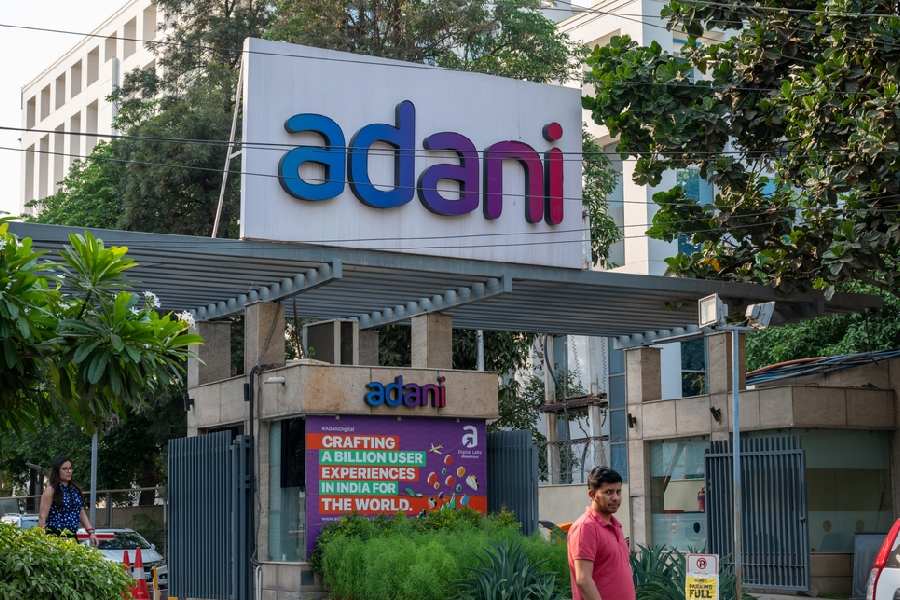In the 1970s, some schools in Calcutta would give a midweek break. If all the homework was done on time, Rajeswari and her mother Ketaki would board a minibus from Ballygunge Phari, get off at the Park Street crossing and walk the rest of the way to New Market. On the way were Hari Tailors, Kalman Cold Storage with its delectable sausages and cold cuts, old record shops selling Soviet imports of Western classical music, secondhand bookshops and Eve’s, the beauty parlour. The road to temptation is paved with anticipation and New Market was no exception.
Nearly half a century since that flashback, the regular haunts of Rajeswari at New Market endure. Albeit with changes and fadeouts.
A jewellers’ has taken to stocking saris. Dayaram, which used to sell only saris, now sells suits and children’s clothes too. Glamour, from which came the French chiffons in Gayatri Devi’s trousseau, has long given way to Mondal Cosmetics. The dry fruits section was gutted in the fire of 1985. Bonani Kakkar, who is an activist, says, “Tall Afghan men sat amidst tall jars of nuts and sweets, hawking their ware — like something out of the pages of Arabian Nights.”
Retired top cop Soumen Mitra recalls, “At the entrance to a clothes store stood mannequins dressed in police and army uniforms, and I ached to be allowed to buy one. Years later, when I wore my police uniform for the first time, the memory of that shop window at New Market floated up, clear and strong.”
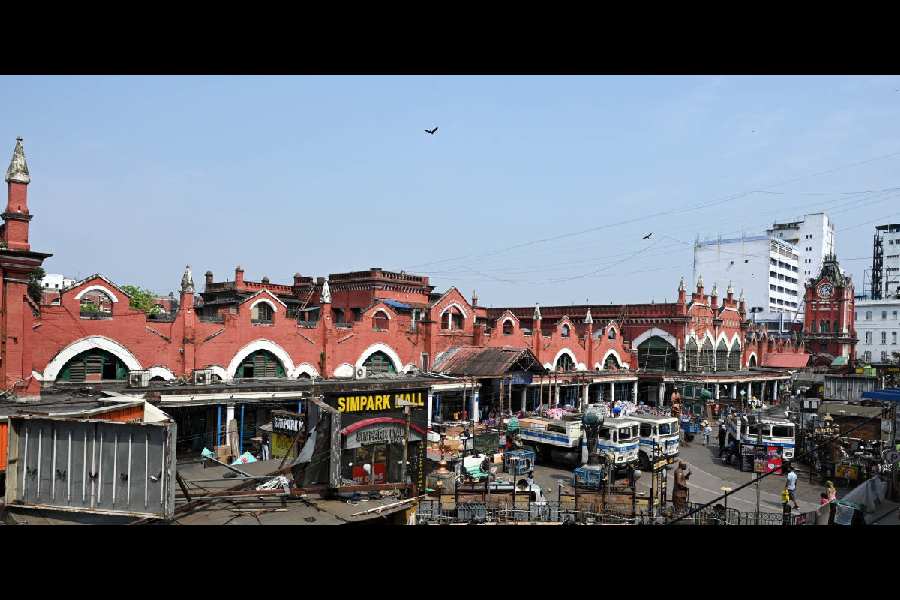
At the centre of the market there was a cannon, a relic of the Boer War. The cannon is gone and with it a fond landmark that helped shoppers navigate the labyrinthine market. “I would always refer to the cannon,” says Bidisha Chowdhury, who is in her 70s.
But you still have Baborally Sirdar with cake moulds of all shapes and sizes, and Geeta’s with its abundance of fabrics. “I still go to New Market for the hand-embroidered petticoats,” says Neelam Mehrotra, a septuagenarian who now lives in Delhi.
Towards the end of the 19th century, the Calcutta Municipal Corporation decided to build what was to be the first planned municipal market of India. A commission was set up to ensure fair pricing and a daily supply of goods. And under the leadership of commissioner and justice for peace Sir Stuart Hogg, an architecture competition was announced. The civic body finally accepted the designs of Richard Roskell Bayne, and Messrs Burn & Co. was entrusted with the construction of the market.
Architect Anindya Basu says, “The architecture of New Market is Victorian Gothic... The Clock Tower was designed almost as an afterthought.”
The outside of the market was built so that temperatures were cooler near the ground. The engineering techniques inside still keep the market functional and not for any surfeit of attention and caretaking.

Thereafter, the British kept adding to Hogg’s dream project. Hogg Market remained the core but given its widening girth, it came to be referred to as New Market. One hundred and fifty years after its inauguration, it still remains new.
The earliest maps of New Market resemble the layout of a township. That’s how Hogg meant it to be. Public toilets, a fire station, a dancing fountain (that no longer exists), row upon row upon row of shops catering to every imagined need. “You can even find tiger’s milk in New Market,” went the popular Bengali saying from the last century.
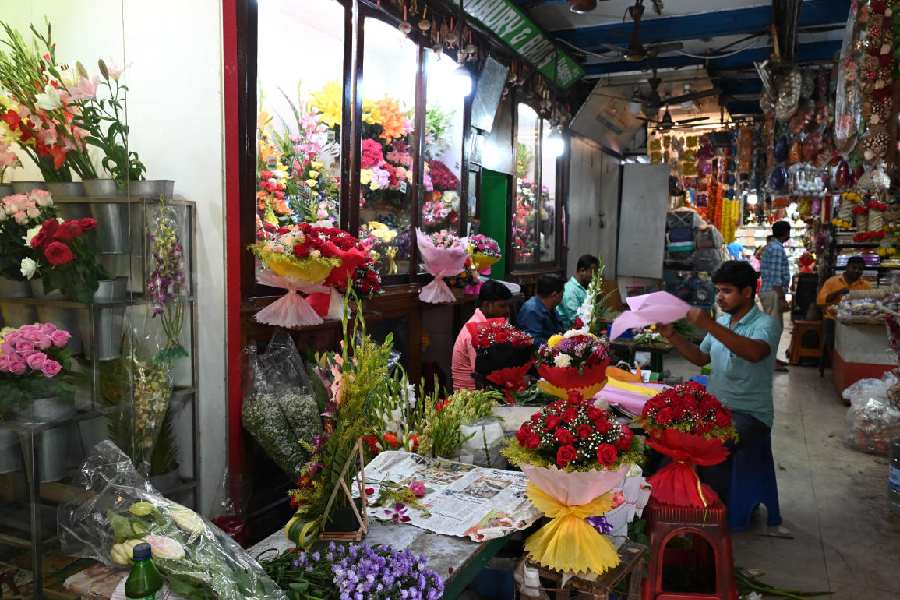
The centre of New Market is a rotunda, which is basically a fancy-funny name for a “roofed building with a circular ground plan”. There is a shop selling beverages and packaged snacks here. A couple from Birmingham, Simon and Sue, was there one afternoon sipping cold coffee. “It is a market with a 60s vibe,” said Simon. “Birmingham too has these old markets that survive alongside modern malls,” he added.
The rotunda is where the shops selling Christmas décor apparate and around it were the sari shops. “My mother used to get her chiffons and chinnons with floral prints from New Market,” says Anuradha Mitra of Bhowanipore.
Radiating from the rotunda are four corridors, each leading to different blocks. Block A’s USP is now wedding wear, though the retailers and nature of collections have changed.
“Till about the 1990s, we would have to bring our visiting relatives from Lucknow and Kanpur here for shopping whenever there was a wedding in the family,” says G.M. Kapur of Intach.
Debarati Chakrabarti, who now lives in San Francisco, US, shopped at New Market for her son’s Hindu wedding last year. “We had a theme-based wedding and I bought a lot of saris and dress material for our US friends from here,” she says.
There are old-world departmental stores like Jamna that sell everything from swimsuits to cardigans, and vintage cosmetic stores like Royal Stores. “Actress-turned-politician Moonmoon Sen would shop for imported perfumes here when her daughters were but toddlers,” says current proprietor Ajay Shaw. The shop was founded in 1900,
but Shaw’s stories are of course from his own salad days, star-studded.
“Tinku Thakur, Sharmila Thakur’s younger sister, was a regular. She would come around for the Binella face cream... Satyajit Ray once came in search of Wilkinson blades. He mentioned our shop in one of his books, “he goes on and on.
There is a reference to Kalimuddin’s dalmut in Ray Jr’s 1996 film Joto Kando Kathmandute.
“Kalimuddin does not exist anymore. Baba used to frequent New Market for the book stores Kalicharan and Khanna. He shot Jana Aranya in the parking lot of New Market and also a lot of Pratidwandi in the part of the market where they once sold exotic birds,” says filmmaker Sandip Ray.
V. Gulab was another landmark shop. “All the trophies for clubs came from there,” says Kakkar.
Paramita Gupta of Ballygunge Circular Road remembers going to Gulab’s to get her silverware polished. The clock over what used to be V. Gulab still hangs, but it keeps its own time.
I have been going to New Market since I was six or seven years old. Then my objects of interest were erasers and pencil boxes,” says Chandana Bakshi, a psychotherapist in her 50s.
“Shopping at New Market instead of Maniktala Market gave north Calcuttans like me status,” says Sushmita Bose, who is based in Dubai now. “I always buy my china from here,” says Sulochana Pandit, who has come shopping for some baking dishes. “The cutlery range is another reason to visit New Market,” adds Bakshi. There are shops like Gangadin Gupta for dress material and sari falls.
And the staidly named Bipin Behari Dass sells lingerie. “We would inwardly squirm as teenagers to have to name our requirements to a bunch of men serving us over the counter,” recalls Rajeswari.
There were toy shops too. And something always for the hip and trendy. “I got my first dungarees from Rahman,” says Soma, who is a boutique owner. Bakshi recalls getting her baggy pants from here.
The shops selling lace, tassels and all things related to needlework are rarities, as anyone who has scoured the city for buttons will tell you.
Almost on the fringes of Hogg Market and close to the gate near Nizam’s is Imperial Bakers & Confectioners, established the year Hogg Market was opened to the public. Here the piece de resistance is the crocodile bread. Current owner Sheikh Parvez Rahman says, “Hogg sahib had given us this space. Those days there were other bakeries — D’Gama, Wise, Nahoum’s.”
Mitra recalls the rows of fudge and green peppermint at D’Gama. Rahman says, “People have stopped coming to this market because of parking problems. Even so there are some elderly loyal clients who park at Bengal Club or even further away and make their way here.”
This is one place where fresh paneer sits cheek by chunk with khoya, stacks of Bandel cheese, Kalimpong cheese, red cheddar cheese and so on. There is also something called guava cheese, which is actually homemade guava marmalade.
Then there are the legendary Nahoum’s and Chamba Lama. “It is these two shops that draw the maximum number of customers to New Market,” says Shaw of Royal Stores. Tshering Yangki of Chamba Lama, now 60-something, has been minding the shop since she was a child while her parents, Cheten Yangjom and Chamba Ongchak, went to Darjeeling to fetch curios and Tibetan jewellery. She will tell you how Aparna Sen wore “our silver choker” to the National Award ceremony, how Suchitra Sen was a client and Usha Uthup still is.
The Chinese shoe shops are mostly gone, though Henry remains and the flower range starts there. Earlier, the flower range was lined with glass-covered shelves encasing bouquets on display overlooking Lindsay Street.
If you turn left from where the florists are, you will come upon the dairy section. Rajeswari’s mother and her friends, who took continental cooking classes at YWCA in the 70s, would shop for sauces, condiments and preservatives here.
The mutton, beef and chicken market is housed in a longish building with sloping skylights that throw natural light inside. “New Market is the only market where you get lamb meat,” says one of the butchers.
Restaurateur Shiladitya Chaudhury of Chowman, Chapter2 and Oudh 1590 says he gets his supply of meat and fish from New Market as well as his pork supplies. The egg and vegetable market is an identical twin of the meat market.
In his collection of short stories titled New Market Tales, actor Jayant Kriplani writes, “...nothing had shaken the historic New Market since its illustrious beginnings in 1874, not the World Wars, not the struggle for Independence; the market thrived no matter who was in power.” And, no matter what the change — hawkers, parking woes, the stench of parallel realities. The porters with their wicker baskets are nowhere to be seen, but the shopkeepers have appropriated their telegraphic lines — “take, take” or “ki lagbe” or the cheeky “no charge for seeing”.
It is hard to resist their call — after all, they are wooing you rather New Market is, instead of having you tick and click.
Shoppers' NonStop

Priyanka Ghosh, Dum Dum
Be it price range or variety, show me another place where you can get anything and everything. And I love a good bargain too! All that the malls have over New Market are air conditioning and clean washrooms.

Susann Lynn Iyer, Beckbagan
Do you know they stock Kalimpong cheese and Bandel cheese here? They also sell barley sugar candy. My relatives who live abroad ask me to buy barley sugar candy for them.

Hasina Mumtaz, Alimuddin Street
The variety of meat and chicken. Now people buy chicken with skin online, but we’ve been buying this from New Market for ages… All the shopping malls look the same to me, but not New Market.
Nikhat Ara, Kidderpore
New Market is something that makes all generations in my family happy... My 70-year-old mother, myself as well as my children. We all come here for both food and shopping.
Oindree Ghosh, Lake Avenue
I have been coming to New Market with Ma since I was a child. My mother’s maternal grandfather owned Globe Nursery, which was just behind the market. Family legend has it that when the lords visited Calcutta in the days of the Raj,the railway station was strewn with rose petals procured from our nursery. So for Ma, NewMarket was a way of life, a habit. If she needed even a needle, we would head for New Market.

For generations we have been getting our spices from here; dress material, lining material from Geeta; glassware and curios from Shau’s; all our kitchenware is from New Market; even our medicine supply used to be from here.
Neha Akhtar and Nilufar Akhtar, Mominpur
We don’t like buying readymade garments, so we come to New Market to get the material. We also get them stitched by tailors here.

Habibur Nahar Doli, Dhaka
I come to Calcutta five to six times a year to shop at New Market. Even though Bangladesh produces the best textiles, in terms of designs and cuts, the clothes here are very good. I got to know about New Market from my khala and cousins back home.
Basudeb and Baishali Saha, Cooch Behar
We come to New Market every time we visit Calcutta, for clothes, shoes, cosmetics.

